全文HTML
--> --> -->聚焦型脉冲星探测器是X射线脉冲星自主导航的核心设备, 相同有效面积的聚焦型探测器的灵敏度比非聚焦型探测器高两个数量级[12]. X射线掠入射光学系统是聚焦型脉冲星探测器的核心部件, 近年来国内多家单位开展了较深入的研究. 中国科学院长春光学精密机械与物理研究所基于玻璃抛光工艺, 研究了用于太阳软X射线观测的光学系统[13], 同时研究了玻璃热弯工艺[14]; 同济大学研究了玻璃热弯工艺, 研制了光学系统样机, 测试的角分辨率达到

本文以XPNAV-1掠入射聚焦型脉冲星探测器的多层嵌套掠入射光学系统为研究对象, 主要研究单次反射抛物面形光学系统设计与仿真分析、基于电铸镍复制工艺的金属反射镜制造、反射镜性能测试; 基于在轨观测数据, 评价了光学系统的有效面积, 验证了光学设计与制造方法, 为大面积掠入射光学系统的研制奠定了基础.
2.1.光学设计
对于探测大量X射线光子到达时间的脉冲星导航而言, 需要牺牲成像所需的高角分辨率, 提高光子通量, 获得仪器的高灵敏度. 使用多层嵌套的抛物面反射镜, 可获得更大的有效面积, 更适合于脉冲星自主导航. NICER和XPNAV-1的在轨性能表明, 单次反射掠入射聚焦型光学系统满足脉冲星导航的需求, 在提高导航精度方面起到了核心作用.单层抛物面反射镜光路如图1所示.
 图 1 单层反射镜光路图
图 1 单层反射镜光路图Figure1. Schematic of optical path of a parabolic mirror.
图1所示为x-y平面内入射到抛物面光学反射镜上的三束平行X射线的反射情况. 从图1可以看出, 由于抛物面具有会聚作用, 三束平行的X射线经其反射后改变方向, 聚焦到一点.
抛物面反射镜的面形公式为
对于掠入射抛物面反射镜, 其顶点曲率半径很小, 通常在反射镜参数初始计算中将其忽略, 即抛物面的面形公式可以简化为




因此, 要以内层反射镜不遮挡外层反射镜反射的光线为原则, 开展嵌套光学系统设计. 假定最外层反射镜为第1层, 为了使各层反射镜具有相同的焦距, 越往内层, 反射镜之间的间隙应该越小. 相邻反射镜之间的关系示意图如图2所示.
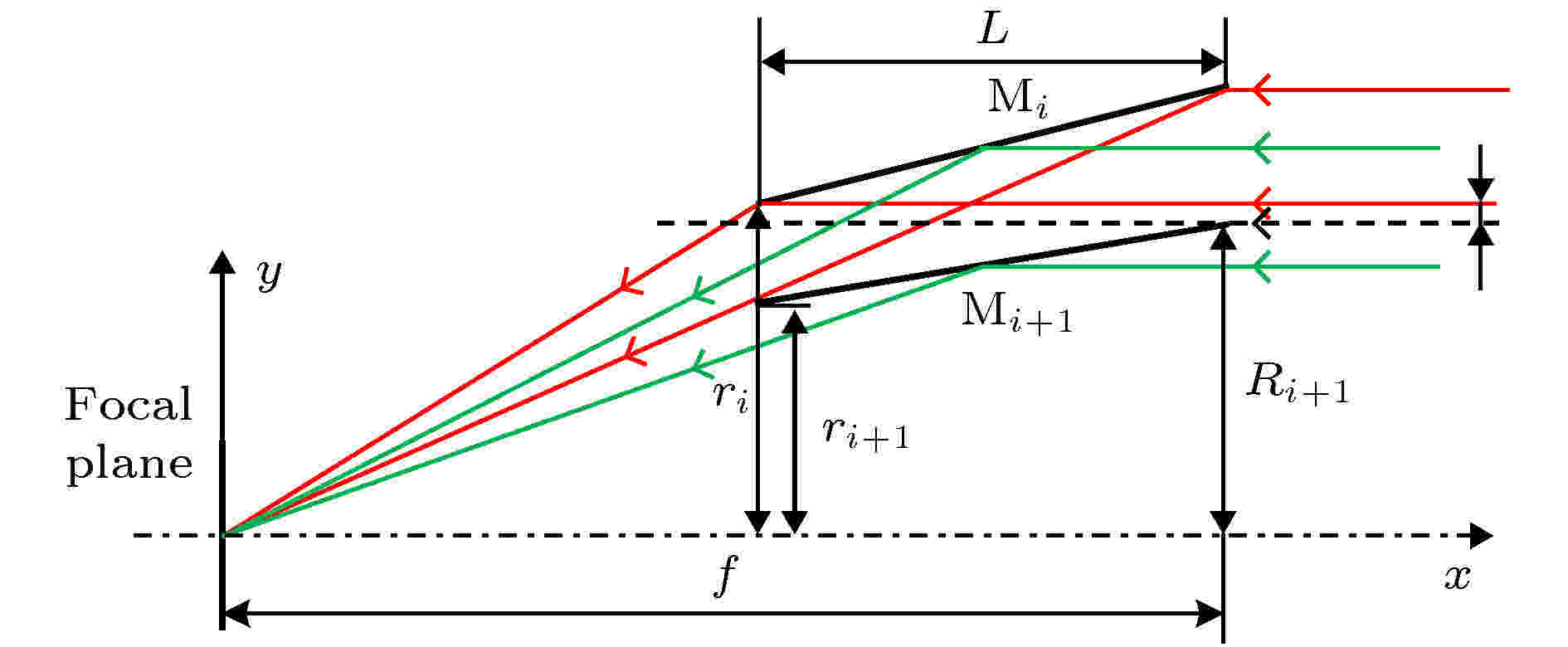 图 2 相邻反射镜之间的关系
图 2 相邻反射镜之间的关系Figure2. Relationship between adjacent mirrors.
基于(3)式中最外层反射镜的参数以及其他内层反射镜的参数递推公式如下:

设计的四层嵌套掠入射光学系统参数如表1所列.
| 项目 | 数值 |
| 能量范围/keV | 0.2—10 |
| 视场/arcmin | 2ω = 15 |
| 焦距/mm | 1100 |
| 掠入射角范围/(°) | 0.98—1.25 |
| 反射镜长度/mm | 120 |
| 反射镜厚度/mm | 0.5 |
| 几何面积/cm2 | 30 |
表1光学系统设计参数
Table1.Designed parameters of the optics.
2
2.2.聚焦性能分析
采用基于空间向量反射的光线追迹方法对掠入射光学系统进行聚焦性能分析, 仿真结果见表2. 视场范围内的任一光线会在探测器敏感面上形成光斑, 光斑的大小和质心位置随视场发生变化, 边缘视场的光斑位于直径5 mm的硅漂移探测器(silicon drift detector, SDD)敏感元范围内, 满足仪器要求.| 视场/(°) | 像斑点列图 | 质心位置/mm | 内环半径/mm | 外环半径/mm |
| 0 |  | 0 | 0 | 0.005 |
| 0.05 |  | 0.99 | 0.95 | 1.03 |
| 0.1 |  | 1.96 | 1.84 | 2.07 |
| 0.125 |  | 2.43 | 2.28 | 2.58 |
表2不同视场下的聚焦情况
Table2.Focusing performance at different FOVs.
2
2.3.反射镜制造
采用XMM-Newton, eRosita等的电铸镍复制工艺制造掠入射光学反射镜[22,23], 该工艺主要包括芯轴超精密加工和反射镜复制, 芯轴超精密加工分为超精车、化学镀镍、磨削、抛光和检测, 反射镜复制分为芯轴镀金、清洗、电铸镍和脱模, 芯轴可重复使用, 实现相同规格反射镜的多次复制, 工艺路线如图3所示. 图 3 反射镜加工工艺流程
图 3 反射镜加工工艺流程Figure3. Fabrication process for mirrors.
采用长程轮廓仪检测对光学系统性能影响最大的芯轴斜率误差, 检测结果如图4所示, 斜率误差的均方根值为0.42 μm.
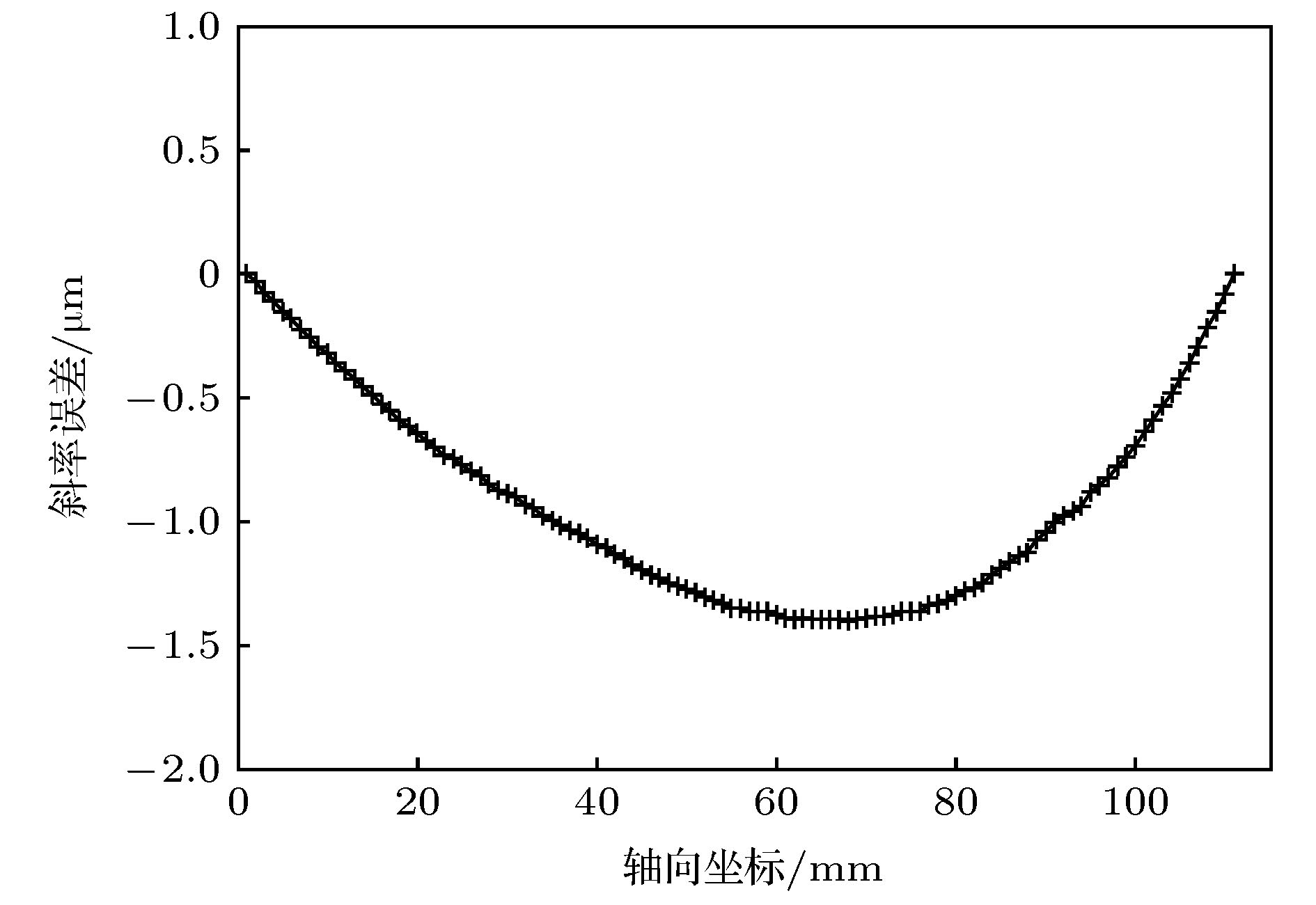 图 4 芯轴斜率误差
图 4 芯轴斜率误差Figure4. Measured slope profile residual of mandrel.
制造的芯轴、反射镜、装配完成的光学系统, 以及整星上的光学系统如图5所示.
 图 5 (a)复制芯轴; (b)复制的反射镜; (c)光学系统; (d)发射前的光学系统
图 5 (a)复制芯轴; (b)复制的反射镜; (c)光学系统; (d)发射前的光学系统Figure5. (a) Mandrel; (b) mirror replicated; (c) optics assembly; (d) optics on the satellite.
2
2.4.反射率测试
X射线反射率取决于反射镜表面粗糙度和镀膜材料, 粗糙度均方根值

反射率测试系统见图6, 安装于中国科学院高能物理研究所的北京同步辐射4B7B束线末端, 主要由光阑孔及调整装置、前置标准探测器、反射镜安装真空腔体、反射镜调整装置、后置探测器和观察窗组成. 将反射镜固定在多自由度调节台上, 由单色仪选出的一定波长的X射线经滤片滤除高次谐波, 通过光阑将杂散光滤除, 照射到前置探测器上, 得到入射光强度, 将前置探测器移出光路, 再由后置探测器测出反射镜反射的反射光强度, 二者比值即为反射镜在特定波长下的反射率, 通过单色仪的能量扫描, 获得反射镜随波长变化的反射率曲线.
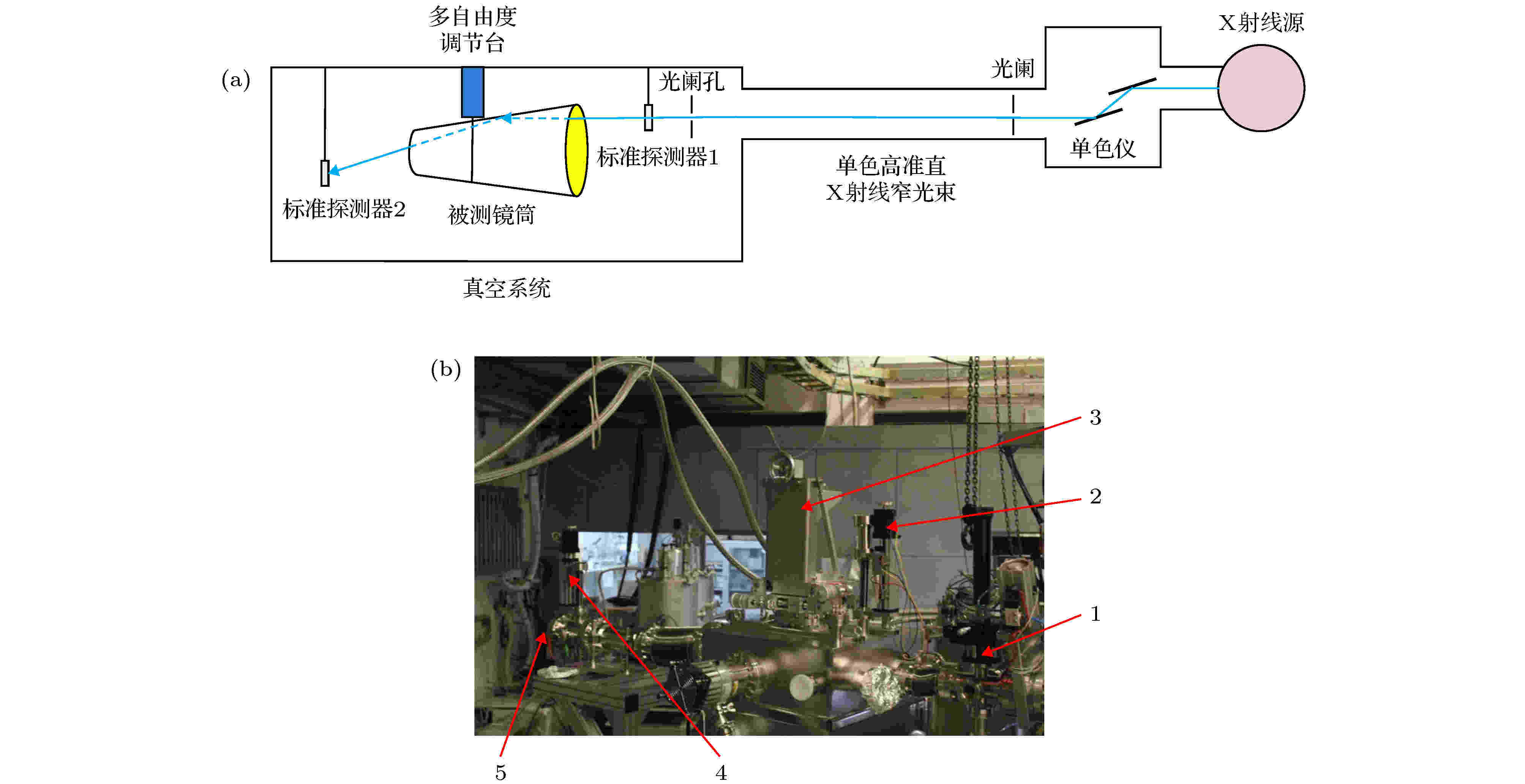 图 6 (a) 反射率测试系统示意图; (b) 反射率测试系统实物图, 其中1, 光阑孔及调整装置; 2, 标准探测器及调整装置; 3, 反射镜调整装置; 4, 测试探测器及调整装置; 5, 观察窗
图 6 (a) 反射率测试系统示意图; (b) 反射率测试系统实物图, 其中1, 光阑孔及调整装置; 2, 标准探测器及调整装置; 3, 反射镜调整装置; 4, 测试探测器及调整装置; 5, 观察窗Figure6. (a) Schematic of reflectivity measurement system; (b) photo of reflectivity measurement system, where, 1, aperture and its adjusting device; 2, standard detector and its adjusting device; 3, mirror adjusting device; 4, measurement detector and its adjusting device; 5, observation window.
以入口端的掠入射角作为反射镜的平均掠入射角, 通过调整反射镜相对于光束线的角度, 分别测试了四层反射镜在其平均掠入射角下0.08—1.6 keV能量范围的反射率, 结果见图7, 从外至内四层反射镜的反射率典型值分别为0.679@1 keV, 0.596@1 keV, 0.658@1 keV和0.719@1 keV. 从图7可以看出, 反射镜2和反射镜4的平均掠入射角小于反射镜1的, 实测反射率却低于反射镜1的, 根据(5)式推导得到反射镜2和反射镜4的均方根粗糙度分别为0.95和0.87 nm, 反射镜1的均方根粗糙度为0.41 nm, 表明反射镜的加工工艺稳定性有待进一步提高.
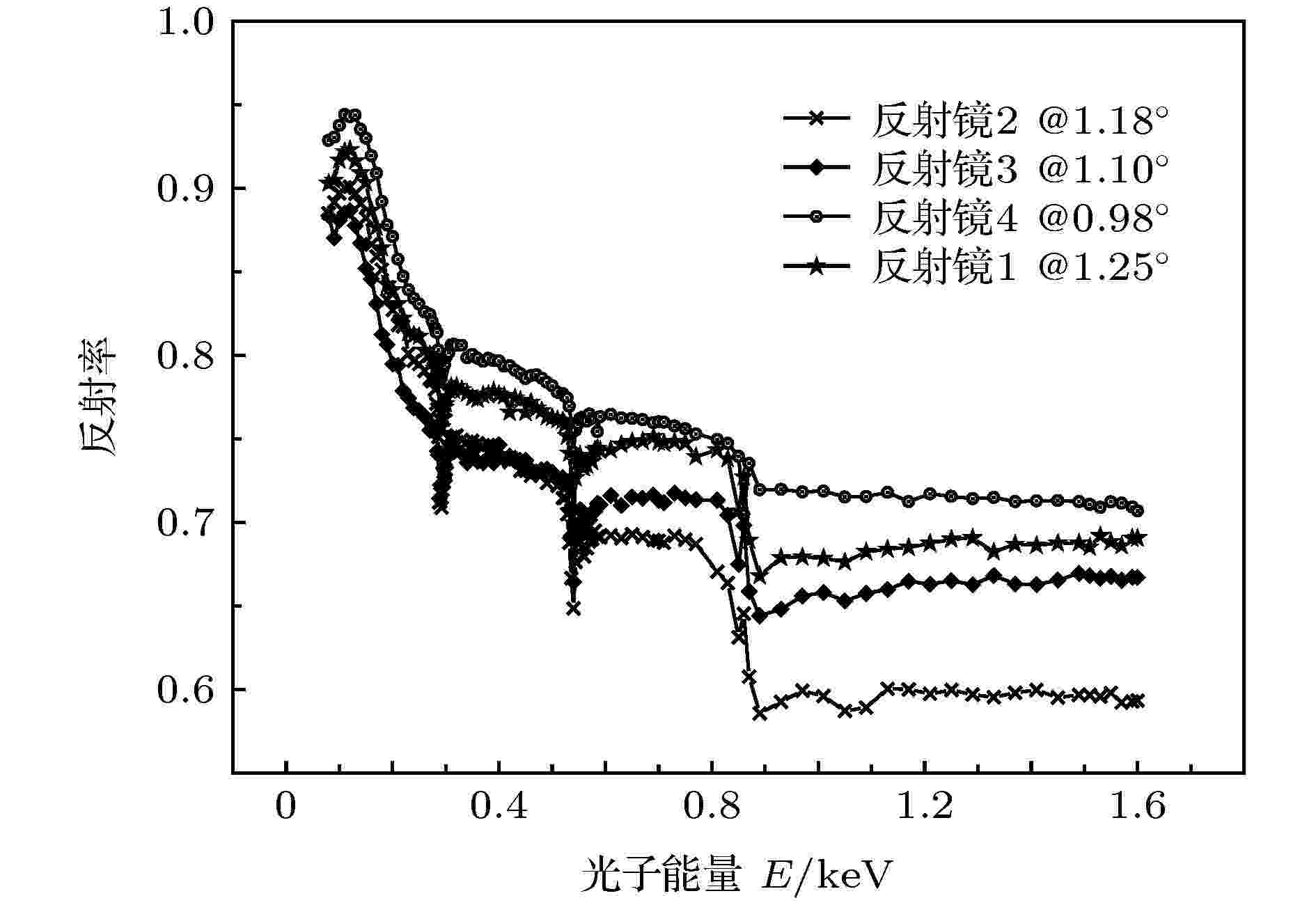 图 7 实测反射率
图 7 实测反射率Figure7. Measured reflectivity.
2
2.5.地面标定有效面积
掠入射光学镜头的有效面积
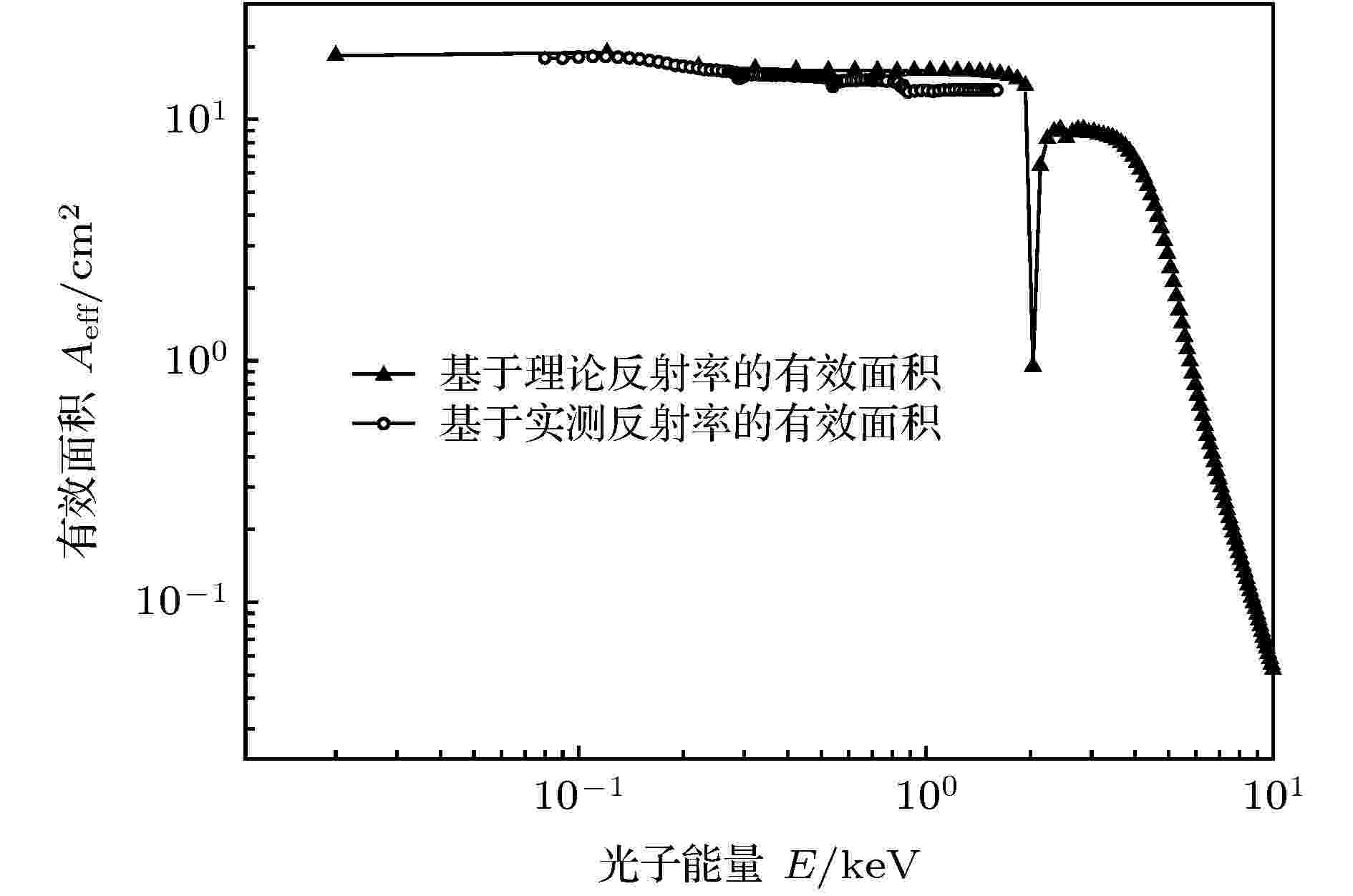 图 8 基于实测反射率与理论反射率的有效面积
图 8 基于实测反射率与理论反射率的有效面积Figure8. Effective areas based on measured and theoretical reflectivity.
从图8可知, 基于理论反射率的有效面积典型值为15.6 cm2@1 keV, 基于实测反射率的有效面积典型值为13.2 cm2@1 keV. 两个典型值存在差别的主要原因是反射率测试过程中标准探测器调整误差、掠入射角测量误差、入射光发散角和反射镜表面粗糙度局部较差等.
2
3.1.目标源特性
在探测器主任务期间, 进入Crab脉冲星观测状态, 获取了探测器在不同时段的Crab观测数据. 探测器观测Crab脉冲星, 每个观测时段内探测器观测到的光子计数率平均流量如图9所示. 在主任务观测期间, 探测器观测得到的光子计数率稳定, 平均计数率为14.7 counts/s[11,24].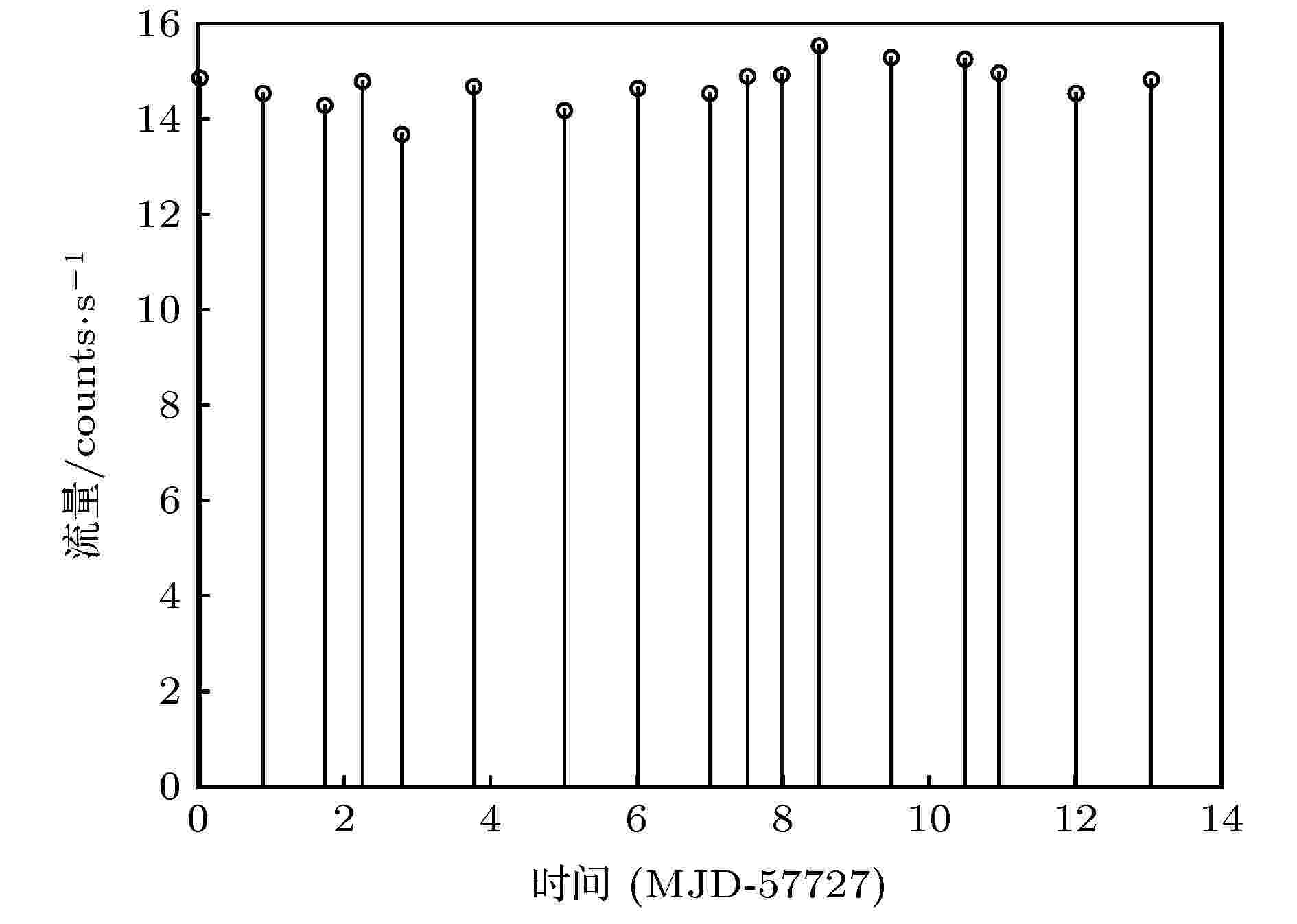 图 9 Crab脉冲星流量时变特性
图 9 Crab脉冲星流量时变特性Figure9. Time-varying characteristics of Crab pulsar flux.
对探测器得到的光子能量信息进行统计, 得到Crab脉冲星的能谱信息, 能谱0.5—5.0keV能段内的光子能谱信息如图10所示, 可以得到脉冲星辐射的光子能量近似呈幂律谱分布.
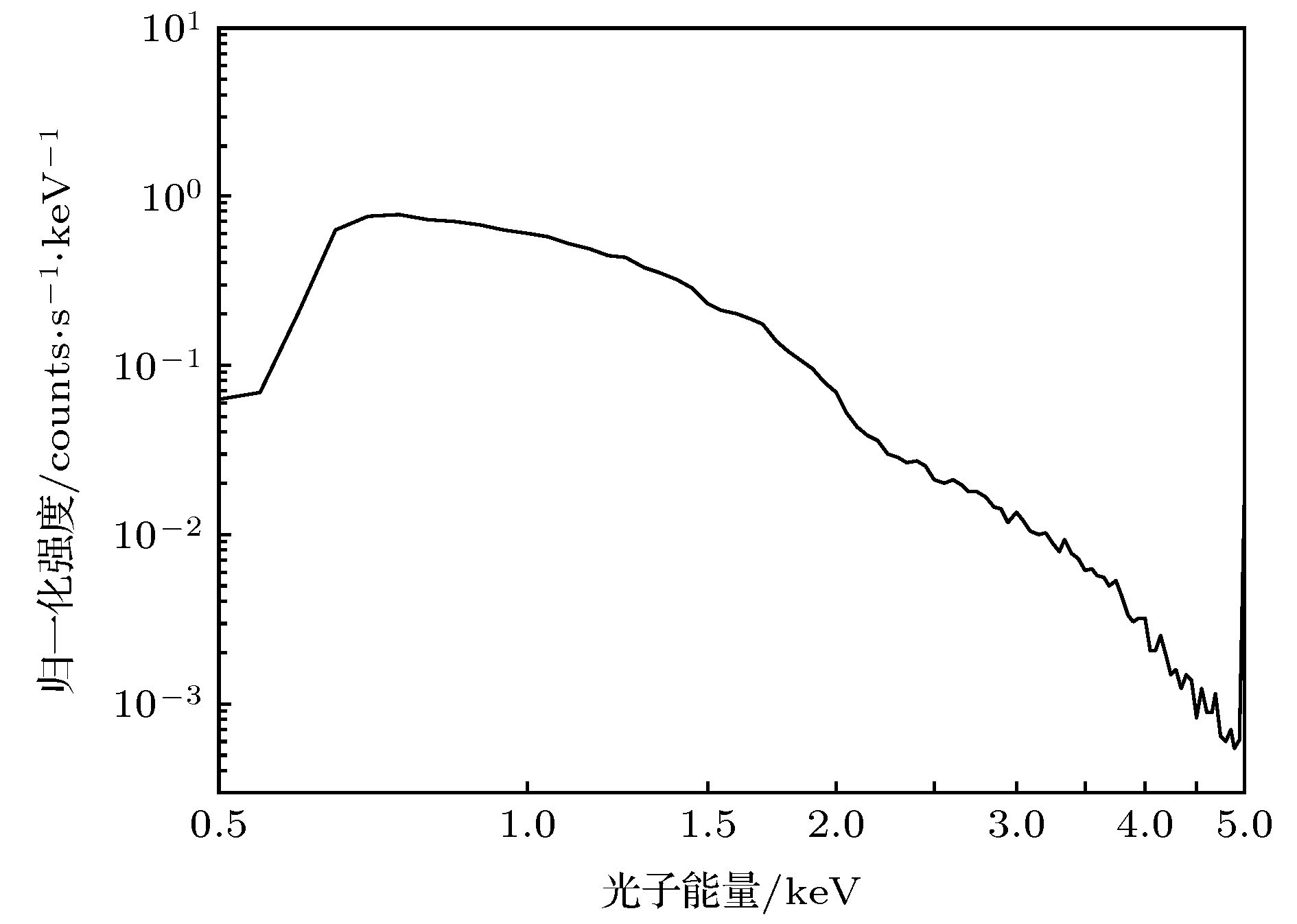 图 10 Crab脉冲星能谱特性
图 10 Crab脉冲星能谱特性Figure10. Spectra of Crab pulsar flux.
Crab星云软X射线波段辐射从约100'' × 100''的天区发出. Crab星云软X射线波段辐射由两部分组成: 星云背景辐射和Crab脉冲星辐射.
Crab星云的辐射流强符合以下分段拟合的解析式(单位: counts/cm2/s/keV):
2
3.2.SDD量子效率
嵌套型X射线掠入射光学系统将Crab脉冲星X射线光子聚焦到SDD探测器上, 因此SDD探测器的响应曲线也会影响光学系统的性能评价.根据SDD探测器使用手册, 分段拟合得到0.2—5.0 keV的SDD量子效率解析式如下:
2
3.3.有效面积评价
光学系统在0.3—5.0 keV能量范围内的效率为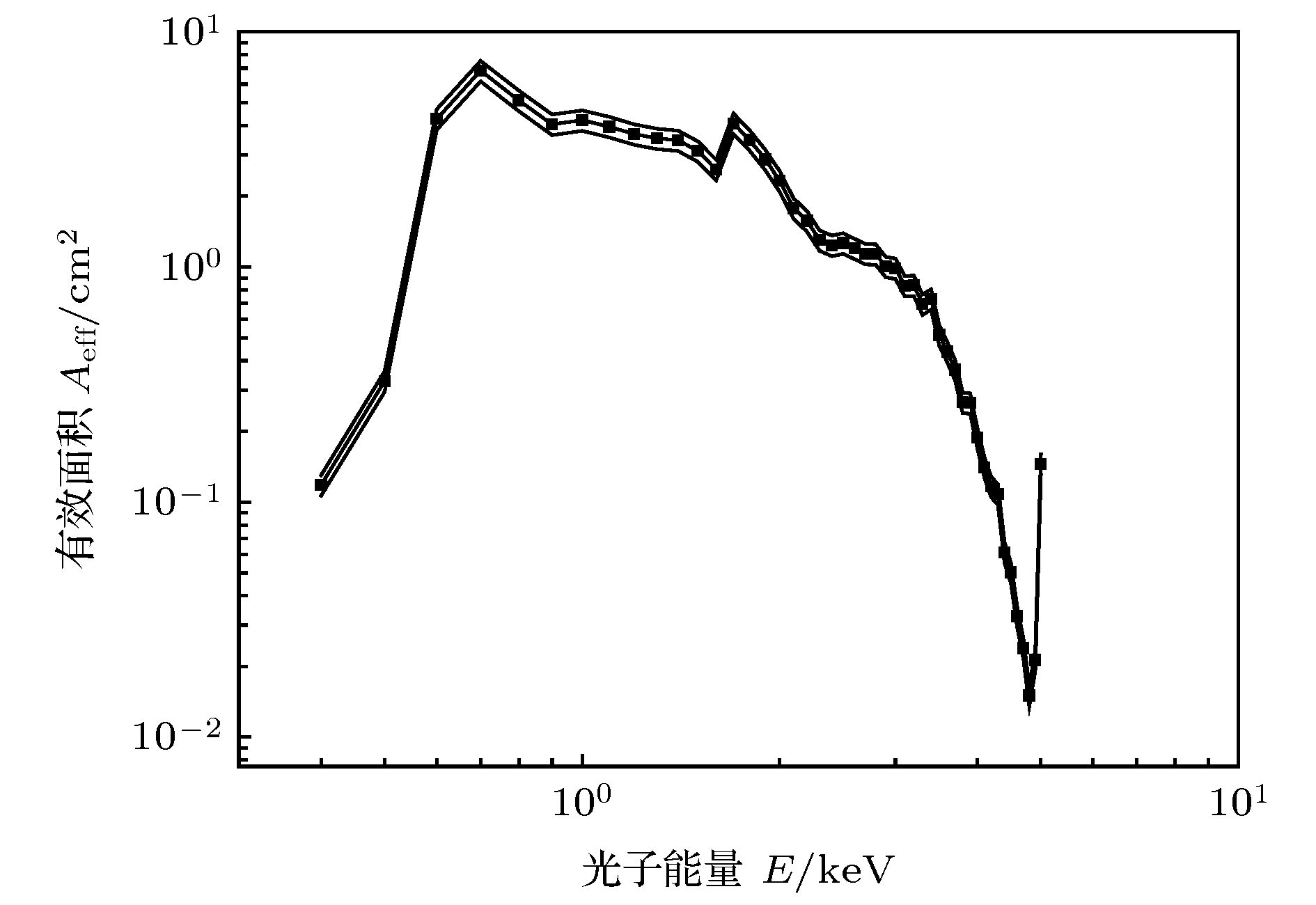 图 11 基于观测数据评价的有效面积曲线
图 11 基于观测数据评价的有效面积曲线Figure11. Evaluated effective area based on in-orbit data.
从图11可以看出, 光学系统有效面积最大值为6.84 cm2@0.7 keV, 典型值为4.22 cm2@1 keV; 0.3—0.7 keV能量范围内有效面积随能量增大而增大, 0.7—5.0 keV能量范围内有效面积随能量增大而减小.
2
3.4.结果分析
对比地面标定有效面积曲线和在轨评价有效面积曲线可知, 典型值从13.2 cm2@1 keV下降为4.22 cm2@1 keV, 且0.3—0.7 keV能段的在轨评价有效面积变化趋势与理论结果不符, 原因分析如下.1)反射镜污染, 导致X射线光子散射, 造成反射率下降. 如图4(d)所示, 星箭对接前将光学系统前端的防尘盖取下, 对光学系统状态进行目视检查, 肉眼可见明显的颗粒状污染物, 反射镜表面的洁净度较测试反射率时出现了明显的恶化; 国外研究过颗粒污染物和分子污染物对X射线光子的散射作用[25,26], 研究表明, X射线能量越低, 污染物造成有效面积下降越大, 可作为反射镜污染造成有效面积下降和低能段变化趋势与理论不符的证据, 后续将深入研究反射镜污染对光学性能的影响.
2)空间热变形导致光学系统与后端SDD探测器之间的相对位置发生变化, 造成反射的部分X射线光子无法入射到探测器敏感元. X射线掠入射聚焦型脉冲星探测器整体为细长筒状结构, 长径比达10∶1, 光学系统和SDD探测器的工作温度相差近70 ℃, 加之复杂热环境的影响, 仪器整体易发生非均匀热变形, 导致光学系统与SDD探测器之间产生相对位置偏差. 同时, 镜片发生热变形也可能是X射线偏出探测器敏感范围, 造成有效面积下降.
3)此外, Crab脉冲星在0.3—0.7 keV能段的流强低, 且SDD探测器在0.3—0.7 keV能段的量子效率低, 从而造成该能段有效面积评价的不确定度增大.
感谢中国科学院高能物理研究所刘树虎老师在反射率测试方面的指导与交流, 感谢中国科学技术大学的邱克强、刘正坤老师在芯轴面形测试方面的讨论.
